ExhibitionsWilliam Kentridge—What We See & What We Know
Thinking About History While Walking, and Thus the Drawings Began to Move…
William Kentridge—What We See & What We Know
Thinking About History While Walking, and Thus the Drawings Began to Move…
HOME > Exhibitions > William Kentridge—What We See & What We Know: Thinking About History While Walking, and Thus the Drawings Began to Move…
![Drawing for the film <em>Felix in Exile</em> [Felix’s room/Nandi with telescope] (1994)](../../../img/2009/376/workImage376a.jpg)
Drawing for the film Felix in Exile [Felix’s room/Nandi with telescope] (1994)
charcoal and pastel on paper; 93×120 cm; coll. the artist; © the artist
The National Museum of Modern Art, Kyoto (MoMAK), is pleased to announce on the behalf of the National Museum of Modern Art, Tokyo (MOMAT) and the Hiroshima City Museum of Contemporary Art (Hiroshima MOCA) the upcoming exhibition, William Kentridge—What We See & What We Know: Thinking About History While Walking, and Thus the Drawings Began to Move…. The exhibition will open at MoMAK in September 2009, and will travel to MOMAT and Hiroshima MOCA in 2010.
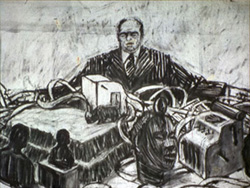
film still from Mine (1991)
animated film using charcoal and pastel drawings;
16mm film transferred to video and DVD; 5:50 min.
coll. the artist; © the artist
William Kentridge (b. 1955, South Africa; based in Johannesburg) began creating his signature ‘drawings in motion’ in the late 1980s. These animated works are created through the painstaking process of photographing charcoal-and-pastel drawings with a 35mm motion picture camera, adding new marks and erasures frame by frame to make the drawings ‘move.’ Kentridge’s films are thus borne from a continuous record of ceaselessly changing drawings. These works are captivating not only for their unique narrativity, but also for the thick accumulation of time, thought, and action that his artistic expression so strongly conveys.
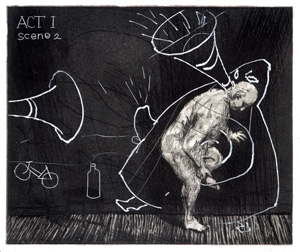
Ubu Tells the Truth (Act I Scene 2) (1996–97)
hardground, softground, aquatint, drypoint and engraving
on paper; 25×30 cm; coll. the artist; © the artist
Kentridge’s works are deeply affected by the history and contemporary social circumstances of South Africa, and his early works, imbued with the pain inflicted by his country’s history of apartheid, have drawn a great deal of attention from all over the world—beginning with such exhibitions as the Johannesburg Biennale in 1995 or Documenta X in 1997—as an artistic expression/practice of anti-Eurocentric postcolonial criticism. However, a closer reading shows that Kentridge’s works have consistently been engaged in the verification and storytelling of the universal and primordial issues faced by humans in the modern age, such as the ambiguity of protection and oppression, or the effort to reintegrate one’s fragmented self and the impossibility of doing so. Furthermore, the artist’s persistent use of the simple technique that he himself has called “stone-age filmmaking” could also be understood as a result of his intent to seek the origins of the narratives created by the modern practice of ‘seeing’, or to uncover the pathology of colonialism from within the Enlightenment as he travels back through history. His powerful works—backed by his vast knowledge in history, literature, cinema, theatre, and music, as well as his extremely sharp intelligence—reach beyond the regional sphere of South Africa and have continued to influence younger generations of artists around the world.
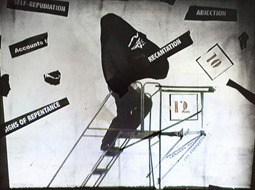
video still from I Am Not Me, the Horse Is Not Mine
(His Majesty Comrade Nose) (2008)
installation of 8 film fragments; DVCAM and HDV
transferred to video and DVD; 6:01 min.
coll. MoMAK; © the artist
William Kentridge—What We See & What We Know allows the viewer to trace Kentridge’s footsteps through a total of 19 films (including 4 film installations), 36 drawings, and 63 prints, from his earliest works in 1979 to his latest in 2008. The exhibition is accompanied by a fully bilingual exhibition catalogue (size A4, or 210×297 mm, 220 pages) with full color plates of all works exhibited, supplemented with texts written by the artist himself, as well as transcripts of the three lectures he delivered in Kyoto and Tokyo in September 2008. It also includes an introductory essay and expository texts by MoMAK chief curator Shinji Kohmoto; an academic essay by professor Jane Taylor; an expository text by Hiroshima Museum of Contemporary Art chief curator Yukie Kamiya; and detailed chronologies and a bibliography. It has been published by MoMAK with the goal of making this catalogue a suitable primary source of future studies of Kentridge’s work in Japan, and also to examine his latest activities in particular.
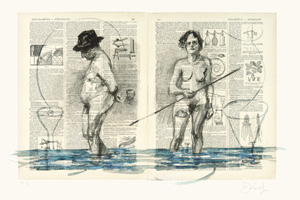
Spectrometre (2000)
digital IRIS print; 44.5×60 cm; coll. the artist; © the artist
What We See & What We Know is the first large-scale exhibition in Japan to introduce the full scope of the works and intellectual challenges of the exceptional artist William Kentridge, up to the present day. It is an enormous pleasure to present this exhibition, long-awaited by both Japanese audiences and the artist himself.
-
Related events
- Exhibition dates
- Friday, September 4 – Sunday, October 18, 2009
- Closed on Mondays
- Exceptions: Open on Sept. 21 (Mon./holiday) and Oct. 12 (Mon./holiday),
- closed on Oct. 13 (Tue.)
- Hours
- Regular hours
- 9:30AM–5:00PM (admission until 4:30PM)
- Evening hours (every Friday)
- 9:30AM–8:00PM (admission until 7:30PM)
- Organizers
- The National Museum of Modern Art, Kyoto
- The National Museum of Modern Art, Tokyo
- Cooperation
- Hiroshima City Museum of Contemporary Art
- Support
- Embassy of the Republic of South Africa in Japan
- Admission
- Advance tickets: Ticket Pia, FamilyMart (P code: 688-804), Lawson (L code:
- 53465), other major ticket vendors and convenience stores
- See also
- Curatorial Studies 03 William Kentridge
- Part I: Artist talks (Kyoto and Tokyo, September 2008)
- Part II: New acquisition (MoMAK, November/December 2008)
- Publicity materials
- Press release (July 1, 2009) PDF file (599KB)
- Poster (B2)
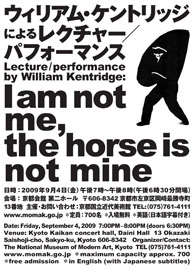 Lecture/performance by the artist:
Lecture/performance by the artist:“I am not me, the horse is not mine”
September 4 (Fri.), 2009
7:00PM–8:00PM (doors open at 6:30PM)
Kyoto Kaikan concert hall (Daini Hall)
Free admission; maximum capacity approx. 700
in English (with Japanese subtitles)
Lecture: “On William Kentridge”
October 9 (Fri.), 2009 5:00PM–6:00PM
The National Museum of Modern Art, Kyoto
1F lecture hall, 3F/4F exhibition halls
Lecturer: Shinji Kohmoto (Chief Curator, The National Museum of Modern Art, Kyoto)
Admission ticket for exhibition required; 30 participants maximum, first come first served
in Japanese only
| Day of admission | Advance | Group (20 or more) | |
|---|---|---|---|
| Adult | 850 | 700 | 600 |
| University students | 450 | 350 | 250 |
| High school students, children under 18 |
Free | Free | Free |

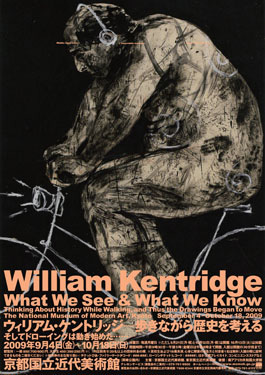
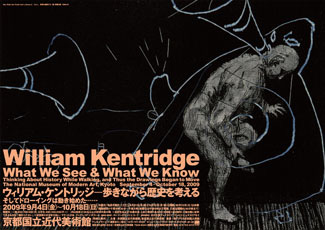
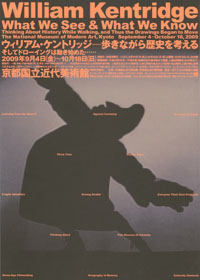
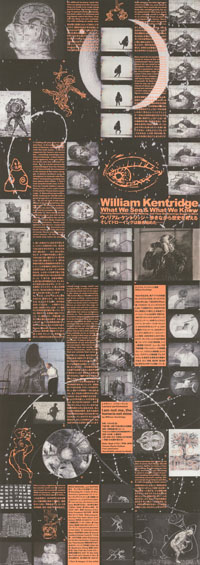
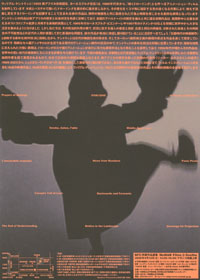
- Other museums
- The National Museum of Modern Art, Tokyo 2010/01/02 (Sat.) – 02/14 (Sun.)
- Hiroshima City Museum of Contemporary Art 2010/03/13 (Sat.) – 05/09 (Sun.)
Top of this page




